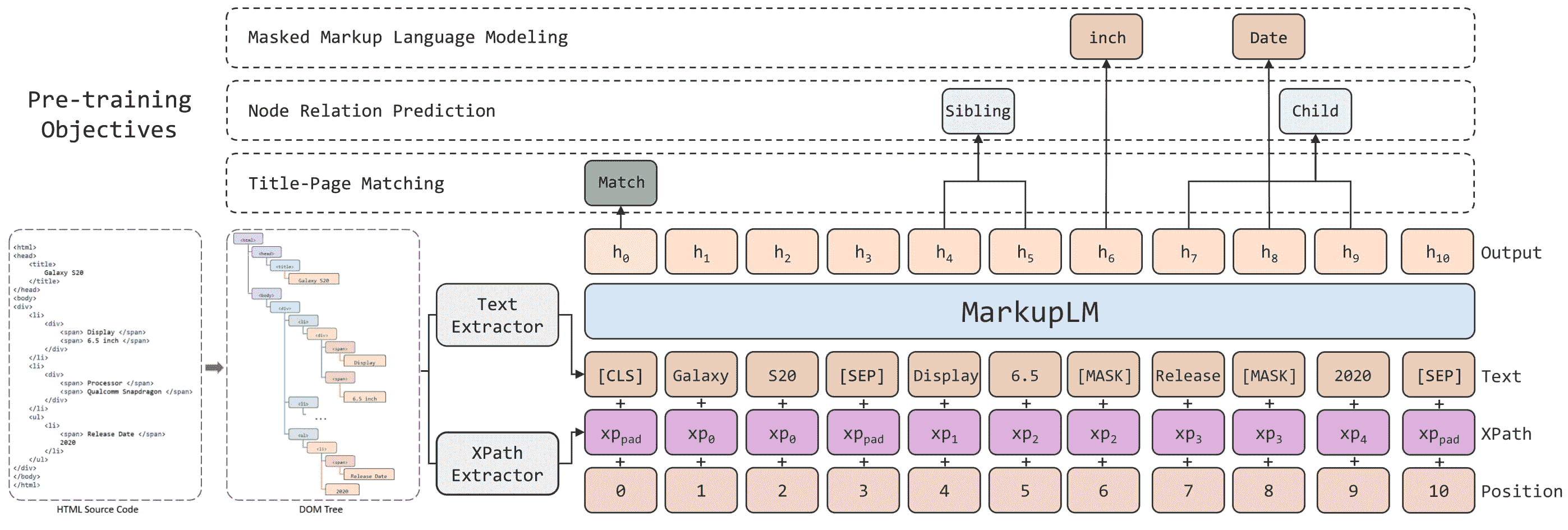序列标注ner原理,CRF作用以及transformers ner使用
1.参考Pre-Training with Whole Word Masking for Chinese BERT(中文BERT-wwm系列模型)https://github.com/ymcui/Chinese-BERT-wwmTransformers: State-of-the-art Natural Language Processing for TensorFlow 2.0 and P...
1.参考
Pre-Training with Whole Word Masking for Chinese BERT(中文BERT-wwm系列模型)
https://github.com/ymcui/Chinese-BERT-wwm
Transformers: State-of-the-art Natural Language Processing for TensorFlow 2.0 and PyTorch.
https://github.com/huggingface/transformers
2.ner理解

输出的是一个句子的每个字的分类,但是为什么要加crf呢?因为神经网络模型学的是每个字的label,考虑左右两边的结果比较少,例如这里小强是个名词,通过crf可以避免出现小B-PER,强B-PER,两个都是B-PER的情况,因为前面一个已经是B-PER了,后面不可能在出现了。
https://blog.csdn.net/qq_27586341/article/details/103062651
3. CRF实现




即一个为单个字符的概率的修正因子,另一个为左右关系的修正因子。
【NLP】用于序列标注问题的条件随机场(Conditional Random Field, CRF)
https://mp.weixin.qq.com/s/79M6ehrQTiUc0l_sO9fUqA
ADVANCED: MAKING DYNAMIC DECISIONS AND THE BI-LSTM CR
https://pytorch.org/tutorials/beginner/nlp/advanced_tutorial.html#bi-lstm-conditional-random-field-discussion
Bi-LSTM-CRF for Sequence Labeling
https://zhuanlan.zhihu.com/p/27338210
4.Transformers NER使用
- 下载预训练模型
Pre-Training with Whole Word Masking for Chinese BERT(中文BERT-wwm系列模型)
https://github.com/ymcui/Chinese-BERT-wwm - 利用transfomers库加载使用
Transformers: State-of-the-art Natural Language Processing for TensorFlow 2.0 and PyTorch.
https://github.com/huggingface/transformers
一些代码细节
- bert是啥

- 具体实现
modeling_bert.py
class BertForTokenClassification(BertPreTrainedModel):
def __init__(self, config):
super().__init__(config)
self.num_labels = config.num_labels
self.bert = BertModel(config)
self.dropout = nn.Dropout(config.hidden_dropout_prob)
self.classifier = nn.Linear(config.hidden_size, config.num_labels)
self.init_weights()
@add_start_docstrings_to_callable(BERT_INPUTS_DOCSTRING)
def forward(
self,
input_ids=None,
attention_mask=None,
token_type_ids=None,
position_ids=None,
head_mask=None,
inputs_embeds=None,
labels=None,
):
r"""
labels (:obj:`torch.LongTensor` of shape :obj:`(batch_size, sequence_length)`, `optional`, defaults to :obj:`None`):
Labels for computing the token classification loss.
Indices should be in ``[0, ..., config.num_labels - 1]``.
Returns:
:obj:`tuple(torch.FloatTensor)` comprising various elements depending on the configuration (:class:`~transformers.BertConfig`) and inputs:
loss (:obj:`torch.FloatTensor` of shape :obj:`(1,)`, `optional`, returned when ``labels`` is provided) :
Classification loss.
scores (:obj:`torch.FloatTensor` of shape :obj:`(batch_size, sequence_length, config.num_labels)`)
Classification scores (before SoftMax).
hidden_states (:obj:`tuple(torch.FloatTensor)`, `optional`, returned when ``config.output_hidden_states=True``):
Tuple of :obj:`torch.FloatTensor` (one for the output of the embeddings + one for the output of each layer)
of shape :obj:`(batch_size, sequence_length, hidden_size)`.
Hidden-states of the model at the output of each layer plus the initial embedding outputs.
attentions (:obj:`tuple(torch.FloatTensor)`, `optional`, returned when ``config.output_attentions=True``):
Tuple of :obj:`torch.FloatTensor` (one for each layer) of shape
:obj:`(batch_size, num_heads, sequence_length, sequence_length)`.
Attentions weights after the attention softmax, used to compute the weighted average in the self-attention
heads.
Examples::
from transformers import BertTokenizer, BertForTokenClassification
import torch
tokenizer = BertTokenizer.from_pretrained('bert-base-uncased')
model = BertForTokenClassification.from_pretrained('bert-base-uncased')
input_ids = torch.tensor(tokenizer.encode("Hello, my dog is cute", add_special_tokens=True)).unsqueeze(0) # Batch size 1
labels = torch.tensor([1] * input_ids.size(1)).unsqueeze(0) # Batch size 1
outputs = model(input_ids, labels=labels)
loss, scores = outputs[:2]
"""
outputs = self.bert(
input_ids,
attention_mask=attention_mask,
token_type_ids=token_type_ids,
position_ids=position_ids,
head_mask=head_mask,
inputs_embeds=inputs_embeds,
)
sequence_output = outputs[0]
sequence_output = self.dropout(sequence_output)
logits = self.classifier(sequence_output)
outputs = (logits,) + outputs[2:] # add hidden states and attention if they are here
if labels is not None:
loss_fct = CrossEntropyLoss()
# Only keep active parts of the loss
if attention_mask is not None:
active_loss = attention_mask.view(-1) == 1
active_logits = logits.view(-1, self.num_labels)
active_labels = torch.where(
active_loss, labels.view(-1), torch.tensor(loss_fct.ignore_index).type_as(labels)
)
loss = loss_fct(active_logits, active_labels)
else:
loss = loss_fct(logits.view(-1, self.num_labels), labels.view(-1))
outputs = (loss,) + outputs
return outputs # (loss), scores, (hidden_states), (attentions)
具体使用可以参考
README.md
## Named Entity Recognition
Based on the scripts [`run_ner.py`](https://github.com/huggingface/transformers/blob/master/examples/ner/run_ner.py) for Pytorch and
[`run_tf_ner.py`](https://github.com/huggingface/transformers/blob/master/examples/ner/run_tf_ner.py) for Tensorflow 2.
This example fine-tune Bert Multilingual on GermEval 2014 (German NER).
Details and results for the fine-tuning provided by @stefan-it.
### Data (Download and pre-processing steps)
Data can be obtained from the [GermEval 2014](https://sites.google.com/site/germeval2014ner/data) shared task page.
Here are the commands for downloading and pre-processing train, dev and test datasets. The original data format has four (tab-separated) columns, in a pre-processing step only the two relevant columns (token and outer span NER annotation) are extracted:
```bash
curl -L 'https://sites.google.com/site/germeval2014ner/data/NER-de-train.tsv?attredirects=0&d=1' \
| grep -v "^#" | cut -f 2,3 | tr '\t' ' ' > train.txt.tmp
curl -L 'https://sites.google.com/site/germeval2014ner/data/NER-de-dev.tsv?attredirects=0&d=1' \
| grep -v "^#" | cut -f 2,3 | tr '\t' ' ' > dev.txt.tmp
curl -L 'https://sites.google.com/site/germeval2014ner/data/NER-de-test.tsv?attredirects=0&d=1' \
| grep -v "^#" | cut -f 2,3 | tr '\t' ' ' > test.txt.tmp
The GermEval 2014 dataset contains some strange “control character” tokens like '\x96', '\u200e', '\x95', '\xad' or '\x80'. One problem with these tokens is, that BertTokenizer returns an empty token for them, resulting in misaligned InputExamples. I wrote a script that a) filters these tokens and b) splits longer sentences into smaller ones (once the max. subtoken length is reached).
wget "https://raw.githubusercontent.com/stefan-it/fine-tuned-berts-seq/master/scripts/preprocess.py"
Let’s define some variables that we need for further pre-processing steps and training the model:
export MAX_LENGTH=128
export BERT_MODEL=bert-base-multilingual-cased
Run the pre-processing script on training, dev and test datasets:
python3 preprocess.py train.txt.tmp $BERT_MODEL $MAX_LENGTH > train.txt
python3 preprocess.py dev.txt.tmp $BERT_MODEL $MAX_LENGTH > dev.txt
python3 preprocess.py test.txt.tmp $BERT_MODEL $MAX_LENGTH > test.txt
The GermEval 2014 dataset has much more labels than CoNLL-2002/2003 datasets, so an own set of labels must be used:
cat train.txt dev.txt test.txt | cut -d " " -f 2 | grep -v "^$"| sort | uniq > labels.txt
Prepare the run
Additional environment variables must be set:
export OUTPUT_DIR=germeval-model
export BATCH_SIZE=32
export NUM_EPOCHS=3
export SAVE_STEPS=750
export SEED=1
Run the Pytorch version
To start training, just run:
python3 run_ner.py --data_dir ./ \
--model_type bert \
--labels ./labels.txt \
--model_name_or_path $BERT_MODEL \
--output_dir $OUTPUT_DIR \
--max_seq_length $MAX_LENGTH \
--num_train_epochs $NUM_EPOCHS \
--per_gpu_train_batch_size $BATCH_SIZE \
--save_steps $SAVE_STEPS \
--seed $SEED \
--do_train \
--do_eval \
--do_predict
If your GPU supports half-precision training, just add the --fp16 flag. After training, the model will be both evaluated on development and test datasets.
Evaluation
Evaluation on development dataset outputs the following for our example:
10/04/2019 00:42:06 - INFO - __main__ - ***** Eval results *****
10/04/2019 00:42:06 - INFO - __main__ - f1 = 0.8623348017621146
10/04/2019 00:42:06 - INFO - __main__ - loss = 0.07183869666975543
10/04/2019 00:42:06 - INFO - __main__ - precision = 0.8467916366258111
10/04/2019 00:42:06 - INFO - __main__ - recall = 0.8784592370979806
On the test dataset the following results could be achieved:
10/04/2019 00:42:42 - INFO - __main__ - ***** Eval results *****
10/04/2019 00:42:42 - INFO - __main__ - f1 = 0.8614389652384803
10/04/2019 00:42:42 - INFO - __main__ - loss = 0.07064602487454782
10/04/2019 00:42:42 - INFO - __main__ - precision = 0.8604651162790697
10/04/2019 00:42:42 - INFO - __main__ - recall = 0.8624150210424085
Comparing BERT (large, cased), RoBERTa (large, cased) and DistilBERT (base, uncased)
Here is a small comparison between BERT (large, cased), RoBERTa (large, cased) and DistilBERT (base, uncased) with the same hyperparameters as specified in the example documentation (one run):
| Model | F-Score Dev | F-Score Test |
|---|---|---|
bert-large-cased | 95.59 | 91.70 |
roberta-large | 95.96 | 91.87 |
distilbert-base-uncased | 94.34 | 90.32 |
Run the Tensorflow 2 version
To start training, just run:
python3 run_tf_ner.py --data_dir ./ \
--model_type bert \
--labels ./labels.txt \
--model_name_or_path $BERT_MODEL \
--output_dir $OUTPUT_DIR \
--max_seq_length $MAX_LENGTH \
--num_train_epochs $NUM_EPOCHS \
--per_device_train_batch_size $BATCH_SIZE \
--save_steps $SAVE_STEPS \
--seed $SEED \
--do_train \
--do_eval \
--do_predict
Such as the Pytorch version, if your GPU supports half-precision training, just add the --fp16 flag. After training, the model will be both evaluated on development and test datasets.
Evaluation
Evaluation on development dataset outputs the following for our example:
precision recall f1-score support
LOCderiv 0.7619 0.6154 0.6809 52
PERpart 0.8724 0.8997 0.8858 4057
OTHpart 0.9360 0.9466 0.9413 711
ORGpart 0.7015 0.6989 0.7002 269
LOCpart 0.7668 0.8488 0.8057 496
LOC 0.8745 0.9191 0.8963 235
ORGderiv 0.7723 0.8571 0.8125 91
OTHderiv 0.4800 0.6667 0.5581 18
OTH 0.5789 0.6875 0.6286 16
PERderiv 0.5385 0.3889 0.4516 18
PER 0.5000 0.5000 0.5000 2
ORG 0.0000 0.0000 0.0000 3
micro avg 0.8574 0.8862 0.8715 5968
macro avg 0.8575 0.8862 0.8713 5968
On the test dataset the following results could be achieved:
precision recall f1-score support
PERpart 0.8847 0.8944 0.8896 9397
OTHpart 0.9376 0.9353 0.9365 1639
ORGpart 0.7307 0.7044 0.7173 697
LOC 0.9133 0.9394 0.9262 561
LOCpart 0.8058 0.8157 0.8107 1150
ORG 0.0000 0.0000 0.0000 8
OTHderiv 0.5882 0.4762 0.5263 42
PERderiv 0.6571 0.5227 0.5823 44
OTH 0.4906 0.6667 0.5652 39
ORGderiv 0.7016 0.7791 0.7383 172
LOCderiv 0.8256 0.6514 0.7282 109
PER 0.0000 0.0000 0.0000 11
micro avg 0.8722 0.8774 0.8748 13869
macro avg 0.8712 0.8774 0.8740 13869
更多推荐
 已为社区贡献1条内容
已为社区贡献1条内容









所有评论(0)